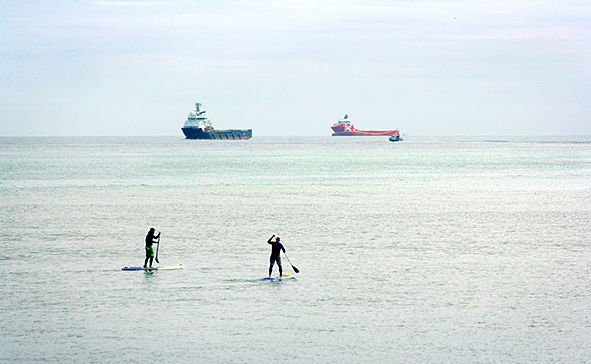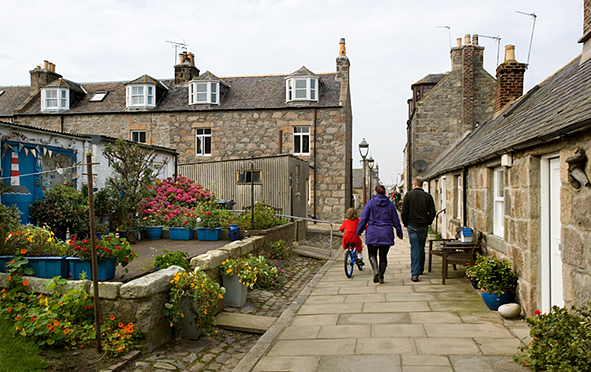When a city with centuries of history is suddenly repurposed for something else, there can be friction. In Aberdeen, the oil industry has had an impact on the city, but 45 years on, is there a greater sense of harmony between the past and present?

Aberdeen Harbour at dusk with Foot Dee nestled in the right corner. (Photo: Paul Tomkins)
Skanky café serves up heaping portions of black pudding, beans and bacon for breakfast. But if you prefer you can have herring. It is a mighty fine way to start a day. I was sat outside at a metal table. Sea skunk air drifted off the North Sea in drafts that ruffled the plastic, green tartan tablecloth.
Somewhere behind the café, squeals of glee rose and fell like waves. A Ferris wheel and a small rollercoaster, with cars shaped like caterpillars with friendly grins, whizzed children to and fro. It felt like a traditional British seaside resort.
But few would ever consider Aberdeen a place to go on holiday. Far from it. What draws most people to Aberdeen today lies out to sea. The only sign of it visible through the salt haze of a watery horizon were large engineering ships, dotted over the sea’s surface like mutant ducks.
Oil
North Sea gas was first discovered in 1965. But there was little interest in the region until oil was discovered in 1969. A year later, a huge oil field called the Forties – which still produces today – was discovered and Aberdeen was transformed into Britain’s Houston.
I wandered through the city centre. I had been given over to believe that the grey of the granite buildings was the only other colour besides the black of the oil. But in the city centre, I quickly realised the extent of my ignorance. Proud old buildings lined the streets. Elegant spires and curved granite bartizans of the Town House suggested a proud history, rich in architecture and culture.

Aberdeen city centre is full of beautiful architecture – fine examples of its rich history. (Photo: Paul Tomkins)
Outside the gothic Marischal College, Robert the Bruce was sat atop a doe-eyed steed, gallantly raising the Grand Charter aloft. You might know of Robert the Bruce from the film Braveheart. He did not make the best impression thanks to the film’s historical inaccuracies. Although a cunning man, Robert the Bruce never betrayed Wallace during battle as it was depicted in the film. In fact, Robert was crowned King of Scots and was ultimately the man to repel the invading English, thus securing Scottish independence at the Battle of Bannockburn in 1314.
Regardless of Hollywood folly, Robert the Bruce forged the Grand Charter in 1319 which made Aberdeen financially independent. Ever since, the city has always been an important site in Scotland strategically and financially. The city was allowed to prosper, which is evident when one walks around the centre, from the old buildings. But there is a distinct absence of modern high rises or swanky glass office blocks.
The oil industry has not commandeered the city as one might imagine. Instead it shares the city; most of the time respectfully. Many offices are located in tech parks outside Aberdeen, and the only place where oil is truly visible on shore is at the port, and this is where the city and the oil industry clash a little.
Water
Earlier in the day I had walked down to the port. Reaching it meant passing through a square known as The Green. There is not a great deal to see there now. A couple of tourists were sat out in the sunshine having lunchtime cocktails.
Transient folk have long been common in Aberdeen. Oil is not the first primary industry to find Aberdeen a useful jumping off point. Hunters and fishers would stop off at the primitive village once located around The Green to rework tools for their trade. Flint discovered there dates back almost 8000 years.

Oil rig support vessels wait offshore before coming into port. (Photo: Paul Tomkins)
The only difference between those early hunters is that the people who stop off in Aberdeen today are more interested in what is below the ground than on it. The port gave testament to this. One of the large ships I had seen on the sea earlier was moored up; its bulky red frame being washed down by industrial hoses.
I followed the water’s edge, shadowed by vast silos and ships. There seemed to be little activity in the mid afternoon, and it did not seem like the area had any residential capacity. An overgrown lot was piled with rusted orange and brown chains the width of my torso. An anchor graveyard: the ghosts of each chain and anchor hoping to be regalvanized. By the entrance a plow anchor twice my height looked forlorn but still capable.
Across the road the cranes and forklift trucks, machinery and oil vanished. They were replaced by terraced houses arranged around an open square covered in grass. Some other small houses and ramshackle wooden sheds and low brick bungalows were dotted over this central area. The streets were impeccably clean, but the houses were decorated with little figurines and creative flourishes.
A fat little porcelain blackbird perched on a wall; an old water pump gushed water through the mouth of an orange lion; Three sailor figurines named Tom, Dick and Harry, a Buddha faced off with a gargoyle; a blue wooden house was covered in mosaic salamanders. Every inch of Foot Dee was touched by whimsy. It was a soulful affront to the oil industry that had parked up on their doorstep.
Foot Dee is an old fishing village positioned at the end of a spit that juts out into mouth of the harbour, as the fresh water of the Dee river meets its larger saline brother The North Sea. Long before Aberdeen had grown and overlapped it, and longer still before anybody had though to make money from oil, the little village had existed.
An 89 year old woman was being conveyed along the streets by her carer in a wheelchair. She told me that she had always lived in the village. Her carer looked over at one of the silos jutting up beyond the village and ‘tutted’.
“Everything has changed since they moved in” she said with derision in her tone.
But it was palpable that tourists and oil were both things she would have preferred not to have in her back garden at all. Both are intrusive. Both are obstacles responsible for complicating a life that could be so simple.
Few if any people in the village fish any more. Long gone are the fishing nets left out on the grass to dry out. An elderly gent in a fetching tweed jacket of blue red and yellow, and a flat cap was showing his son and their young family around the village.
“I’m what’s known as a city father” he told me in a thick molasses accent. “Fittie here used to be further up the river two hundred years ago, but then a flood destroyed all the houses and they moved here.”
His grandchildren seemed restless. Perhaps they had heard this all before. “Of course Fittee is different, but as long as the oilmen respect the history of this city, then we can all get along fine.” The family moved on as the city father pointed out some point of interest to the youngest granddaughter: a squirrel with a rucksack climbing a plant pot.

Families wander through the peaceful old Foot Dee fishing community. (Photo: Paul Tomkins)
Inky Black
Dusk fell over the city of Aberdeen. One of the thirty ships that had been hovering off-coast all day ploughed through the ashy water into port.
“They stay out to sea until they really need to come in” said Jim, a photographer who had set up shop on top of the coastal golf course looking out over the city as the sun sank. “If they stay a couple of miles out they don’t have to pay anything. Staying in port is expensive.” We watched as the colour leach from the sky as one ship after another came in to dock.
Night had fallen over Aberdeen. I bade goodnight to Jim the photographer and walked down from the golf course towards the city. Moonless and cloud covered, the only thing breaking night’s infernal ink over the North Sea were the lights of progress of a finite industry. Beyond the cranes and vats of the harbour, the faint lights of Foot Dee nudged their way across the estuary to me – a reminder that our need for food will long outlast our need for oil.